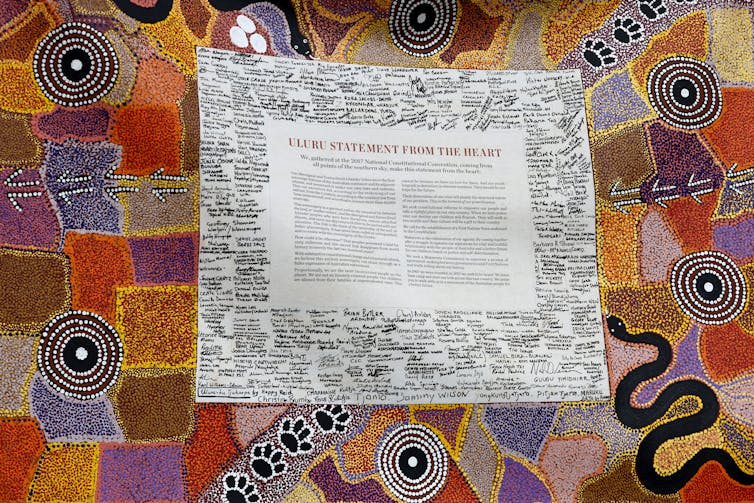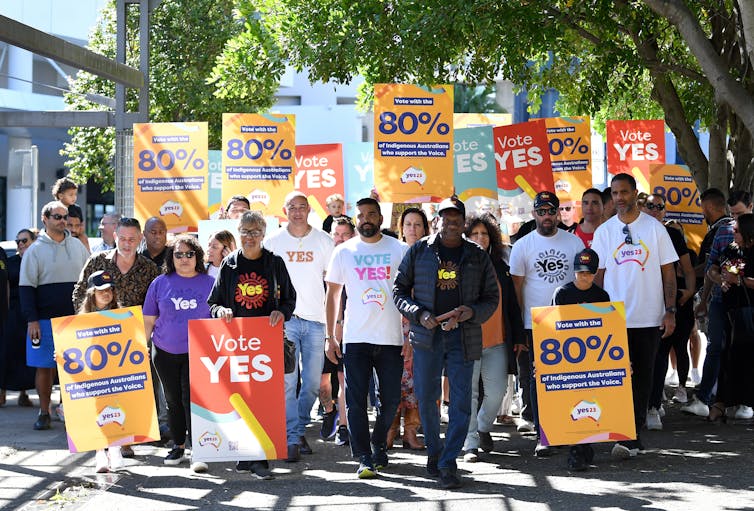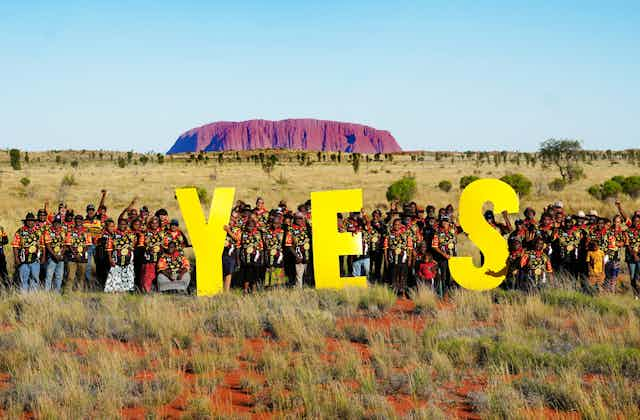This Saturday is the final day of voting in the Voice to Parliament referendum, which asks Australians to support recognition of First Peoples in the Constitution and enable First Peoples’ representation on relevant policies and programs.
Over the last several weeks, I have attended many events supporting and advocating for the Voice referendum. In these forums, my fellow Australians talk about the Constitution, the role of government and how power is exercised in modern democracy. Some have never read or thought about the Constitution before.
I’ve seen young First Nations lawyers explaining to a mixed crowd how the Constitution works, what is included in it and what a constitutionally enshrined Voice would mean. I have been invigorated by such sincere participation in understanding how our democracy works, and could work better.
This serious contemplation was getting underway at the Referendum Council’s Aboriginal regional dialogues I attended in 2017. With other Aboriginal people, we discussed what change could look like. I have supported the implementation of the Uluru Statement from the Heart and played my small part supporting the “yes” vote at my university and with my family and community.
Read more: Your questions answered on the Voice to Parliament
How opinions have differed
Debates around the Voice have presented three competing narratives to the Australian public.
The “yes” position addresses the outstanding business of the place of First Peoples in the life of the nation. This position is an offer of peace, to walk together towards settlement. It also believes that if First Peoples are able to work with and through government – with power devolved to local-level decision-making – the everyday experiences of the disadvantaged will be changed.
The Voice proposal is a modest, middle path. It’s a compromise position that was believed to have the greatest chance of gaining support from progressives, liberals and conservatives.
The “no” position refuses to acknowledge the unique place of First Peoples in the life of the nation and rejects any perceived “special treatment” based on either disadvantage or cultural difference.
A third, minority group is the so-called “progressive no” vote, which rejects the Voice referendum as an unacceptable compromise with limited utility as a mechanism to advance First Peoples’ rights. It argues Voice is not enough, and it’s time instead for recognition of sovereignty.
Each of these narratives draws from competing versions of the story of the nation’s past and future. We can see that understanding our history is more important than ever in addressing the politics of disruption and disinformation and the toxic social and political discourse that has dominated the campaign.
Right-wing tactics of division
Debate over the referendum has played out in a different way to other referendums and general election campaigns. The debate has often been discourteous, relying on a swarm of cruel, derogatory and racist social media posts. Some leading “no” campaigners have presented increasingly extremist and sensational views intended to dominate the news cycle and social media.
In many ways, the “no” campaign has followed patterns of right-wing campaigning from overseas, which is intended to destabilise the social relations, trust and confidence we have in one another and seed division.
Consider the Brexit debate in the UK, and or US Capitol insurrection and claims of a stolen election by former President Donald Trump. Each provided a platform for people to express white nationalist sentiments and their deep distrust in the institutions of democratic government.
The “no” campaign’s tactics have also sought to link a host of disparate themes to the referendum, from climate change denial to anti-vaccination beliefs. The common theme is grievance against the perceived extension of the distrusted government into people’s lives. Disinformation has played a key role.
Other concerns have also been publicly raised about the Voice, such as that it would be a risk to people’s private land. These concerns are sincerely feared, but totally unfounded.
Difficulties confronting our history
What sits beneath this right-wing rhetoric in Australia is the highly charged debate over the nation’s past and its future.
Contesting views about Australia’s history should not come as a surprise. Since historians became more interested in the telling of Australian history “from the other side” and writing First Peoples back into the nation’s story, it has been met with an equal measure of resistance and shock.
The ongoing difficulty of “coming to terms” with colonial histories can be attributed to a number of things:
historical amnesia, disbelief or cultural differences over what counts as historical knowledge
the strategic use of “forgetting” to protect a social group’s self-image
and the belief that engaging in these difficult histories is somebody else’s responsibility rather than our own.
The Voice Referendum and Uluru Statement introduce a new nationalism underpinned by a different origin story: the process of a settlement between First Nations and non-Indigenous Australians with a recognition of how our continent’s much deeper history can be a gift, or inheritance, to all Australians.
In this vision for the future, the worlds of Aboriginal and Torres Strait Islanders narrate the story of the country over much longer timeframes through an entirely different archive and knowledge system.
The idea of inheritance of a much deeper and longer history of country is less concerned with colonial settler-Indigenous relations. Rather, it is a transformed sense of history that extends over thousands of generations and speaks to place.

Playing a role in the future of the nation
The aim of the Voice is to strengthen democracy by meaningfully engaging with those who have the knowledge and expertise, in local conditions and contexts, to improve government decisions in Indigenous policy and programs.
The Voice proposal eschews a rights framework in favour of providing
the impetus for a profound paradigmatic shift between Indigenous peoples and the state. While this “power of influence” on one hand seeks to improve policy and programs and services on the ground, it also seeks to shape a new and meaningful relationship between Indigenous Peoples and political institutions.
There is a legitimate and important role for government to play in First Peoples’ lives, but this role can be improved by greater participation and local-level input in the design and implementation of policy and programs.
For too long, First Peoples have experienced the worst excesses of government and its various instruments – namely the police and judiciary. There’s a reason why many people hold a deep and abiding fear and suspicion of government. It has been responsible for many traumas:
the brutal dislodging of kinship connections
the taking of land without any legal basis or compensation
the violent dispersal of people from their land, which has rendered many destitute and without means to care for their families
the removal of people’s children, denial of basic services and assistance, and management of people’s lives by a cruel and underfunded protection board
the empowering of police and military to seize people’s community assets.

And yet, the Voice referendum, supported by the overwhelming majority of First Peoples, seeks to improve the relationship with governments to achieve greater efficiency and effectiveness of policies intended to improve lives.
At one Sydney “yes” rally, we walked from Redfern Park along Cleveland Street to Victoria Park. It was a massive turnout that far exceeded expectations. The mood was serious, yet joyous. People came from all over Sydney and brought their place with them – the crew from “The Shire” got a big cheer from the crowd.
This gathering was not looking for division, but rather a heart-filled yearning to come together as a community of people and play a role in the future of a nation that’s accepting of the fact it’s our country, too.

